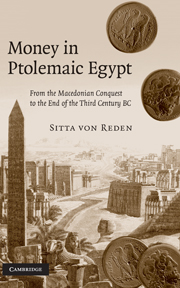Sitta von REDEN, Money in Ptolemaic Egypt

Money in Ptolemaic Egypt
From the Macedonian Conquest to the End of the Third Century BC
Sitta von Reden
Universität Augsburg
Hardback
(ISBN-13: 9780521852647)
Blurb from CUP
First book to explore the impact of Alexander the Great’s introduction of coined money on the economy and society of Egypt and its political implications for the formation of the Ptolemaic state. It argues that the introduction of coinage happened slowly, spreading gradually from Alexandria into the chora. Under Ptolemy II, however, Egypt was aggressively monetised. Using both numismatic and papyrological evidence, the workings of a rural monetary economy are reconstructed where coinage was in high demand but short supply. It is argued that by the middle of the third century BC Egypt was much more thoroughly monetised than is usually assumed, but that the degree of monetisation was sustained only by an extensive credit economy as well as ad hoc commutation of monetary payments into kind. Contextualising the complexities of credit and banking in rural Egypt, the book offers a new picture of their function in the ancient economy.
• Makes accessible the very rich but complicated evidence for the economy of Ptolemaic Egypt
• Describes the complexities of money use, credit and banking in a rural economy and society
• Makes a significant contribution to the debate on the ancient economy
Contents
Introduction; 1. Questions and issues; 2. The historical background; Part I. Money and Coinage: 1. The money of the King; 2. Monetising the countryside; Part II. Cash and Kind: 3. Taxes; 4. Bronze and silver; 5. Rents; 6. Wages; Part III. Debt and Credit: 7. Formal loans (List 1-2); 8. Extending the credit economy (Lists 3-5); 9. Leases and labour contracts; 10. Credit in a social context; Part IV. Banking: 11. Banks and money supply; 12. Banking and business; Conclusion; Appendices.

<< Home